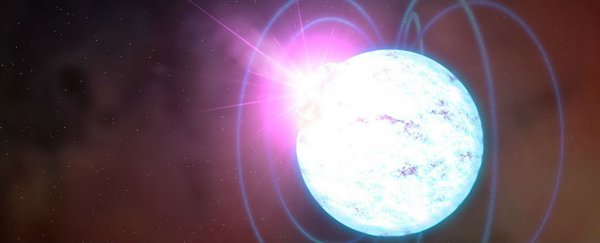A massive cloud of high-energy particles called a wind nebula has been spotted encircling an incredibly rare ultra-magnetic neutron star - or magnetar - for the first time.
This is a pretty big deal, because of the 2,600 or so neutron stars astronomers have found to date, only 29 have been classified as magnetars, and until now, none have ever been found wrapped in a nebula.
Identified using NASA's Swift satellite, the nebula is floating around a magnetar called Swift J1834.9-0846 - J1834.9 for short - which was first discovered back in 2011.
"Right now, we don't know how J1834.9 developed and continues to maintain a wind nebula, which until now was a structure only seen around young pulsars," said lead researcher George Younes from George Washington University.
"If the process here is similar, then about 10 percent of the magnetar's rotational energy loss is powering the nebula's glow, which would be the highest efficiency ever measured in such a system."
First off, what exactly is a magnetar? Well, let's just say if you had to choose a favourite type of star, a magnetar is pretty much your best choice.
They're the most powerful magnets in the Universe, they erupt without warning - sometimes for months on end - and NASA says they generate a gravitational pull so powerful that a marshmallow impacting its surface would hit with the force of 1,000 hydrogen bombs.
Magnetars are a type of neutron star, which the crushed core of a massive star that collapsed under its own weight when it ran out of fuel, and exploded as a supernova. Neutron stars that spin are often called pulsars.
Magnetars generate enormously powerful magnetic fields, up to 1,000 times stronger than those of ordinary neutron stars. As NASA explains, the magnetic field of a magnetar measures a "million billion Gauss, or about a hundred-trillion refrigerator magnets. For comparison, the Sun's magnetic field is only about 5 Gauss".
Researchers aren't entirely sure how magnetars work, but they aren't powered by things like nuclear fusion, like our Sun, or rotation, like regular neutron stars. In fact, magnetars rotate relatively slowly, completing a rotation once every 7 seconds (give or take), compared to less than 1 second for your average neutron star.
They appear to be powered by magnetic field decay, which causes them to emit high-energy electromagnetic radiation, such as X-rays and gamma rays, which gives them their intense glow.
Younes and his team have been studying J1834.9 since its discovery, and using the European Space Agency's (ESA) XMM-Newton X-ray observatory, spotted a strange glow stretching 15 light-years across, and forming around the magnetar.
Further observations confirmed the existence of this wind nebula, making it the first one ever to be found around a magnetar.
"For me the most interesting question is, why is this the only magnetar with a nebula? Once we know the answer, we might be able to understand what makes a magnetar and what makes an ordinary pulsar," says one of the team, Chryssa Kouveliotou from George Washington University.
Wind nebulae are formed when spinning neutron stars - or pulsars - combine with a powerful magnetic field to accelerate electrons and other particles to very high energies. This creates a pulsar wind that develops into a wind nebula, like the one located at the centre of the famous Crab Nebula supernova remnant.
What's strange is that physicists thought only young pulsars could hold onto wind nebulae, because they spin fast enough to stop them from streaming out into space. As a pulsar ages and slows down, it becomes too weak to hold back the particles. So how can this magnetar, which spins even slower than a regular pulsar, be holding onto its nebula?
The team plans to continue their investigation to figure that out, and they sound pretty hyped about it. "It represents a unique opportunity to study the magnetar's historical activity, opening a whole new playground for theorists like me," says Jonathan Granot from Israel's Open University.
The find has been accepted for publication in The Astrophysical Journal, and you can access it at pre-print website arXiv.org.
